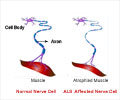Diagnosis of Amyotrophic Lateral Sclerosis (ALS)
Diagnosis of ALS is rather difficult because the symptoms resemble other neurological conditions.
Signs of upper and lower motor neuron damage in a single limb, that cannot be assigned to other conditions, is a near- definite indicator of ALS.
The primary diagnosis is based on the medical history, along with the signs and symptoms resembling those of ALS that a doctor notices in the patient. A series of tests are then prescribed to confirm the diagnosis and to rule out other diseases.
Diagnostic tests should be conducted to rule out other nervous disorders that resemble ALS. Some of the important ones include:
- Electromyography (EMG) detects electrical activity in the muscle.
- Nerve conduction velocity (NCV) test is carried out to measure the conduction ability of the nerve. NCV could also indicate peripheral neuropathy so further tests are required.
- Magnetic resonance imaging (MRI) is a non-invasive procedure that is employed to take detailed images of the brain and spinal cord. MRI can rule out herniated disk in neck, spinal cord tumor, cervical spondylosis and other disorders.
- Spinal tapor lumbar puncture may be carried out to draw the fluid surrounding the brain and spinal cord, with the help of a needle, and subjecting it to examination.
- Muscle biopsy is carried out to rule out any myopathy.
- Blood and urine tests may be carried out to rule out other suspected diseases.
The patient must always go for a second opinion as there is a lot of ambiguity associated with the diagnosis of ALS. As a result of the symptoms overlapping with those of other diseases such as AIDS, human T-cell Leukemia, Lyme disease, multiple sclerosis, post-polio syndrome, spinal muscular atrophy and multifocal motor neuropathy.










